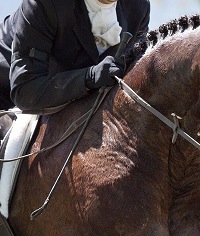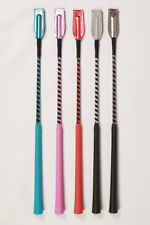By Maddy Butcher
The more you use a whip, the less successful you’ll be over jumps. But carry one without using it and you may do better than without one.
That’s the gist of recent research by Catherine Watkins and Darcy Murphy of Hartpury College in England. Their findings were included in the proceedings of the International Society of Equitation Science conference held last month in Delaware. Click here for ISES pdf.
Taken at its most basic, the research correlates nicely with the barrel racing study done by Karen Waite at Michigan State University. She found that aggressive riding (with whipping and spurring) did not make for faster barrel runs and negatively impacted cooperation from horses.
The Watkins-Murphy study looked at about 500 horse and rider pairs in British show jumping, at elite and non-elite levels. It found that the likelihood of faults increased with greater whip use. The researchers also discovered that novice riders use and carry whips a bit more than elite riders (a finding noted in the barrel racing study, too).
Sixty-nine percent of novice riders carry whips, compared to sixty-two percent of elite riders.
But the correlation between simply carrying (as opposed to using) a whip and jumping clear rounds shows an interesting element that begs for further study:
- Twenty-three percent of riders carrying but not using whip had clear rounds.
- Sixteen percent of riders without a whip got a clear round.
- Just seven percent of whip-using riders got clear rounds.
Could these results reflect rider confidence or horses knowing of the whip prospect?
Future research might test jumping rounds of the same horse and rider pairs with and without whips.
Whips seem to be increasingly viewed as counter-effective by the academic world. Dr. Paul McGreevy and others have shown as much in their investigation of Australian thoroughbred racing. And indications are that the studies may have some impact on the policies related to equine welfare.
For the record, some critics say these researchers are confusing cause with correlation:
• Novice horses need to be reinforced and disciplined with the whip.
• Novice riders need to use aids like whips until they refine their technique.
• When the horses learn and partnerships get better, the whip goes away, critics say.
It’ll be interesting to see if the British Showjumping Association amends its rules to deter whip use.
- Would they find another piece of gear to replace it?
- What’s more important to British Showjumping and to its competitors – successful performances or what’s best for the horse?
At the very least, this British study helps us see that any tool – spurs and whips included – can be abusive or effective. It’s up to us as riders to use them appropriately and with respect for the welfare of the horse.


I go back to my comment on whether we should wear riding hats or not.
If more people used natural horsemanship methods & built a true relationship with their horse so that they worked in partnership & asked a horse to work willingly, instead of coerce or forcing a horse to do as they wanted, a whip would not be needed at all.
Please have a look at some of Pat Parelli’s videos – he can get a horse to do some amazing things without it even being saddled or bridled & he is sat on another horse getting them both to do passage & piaffe.
Just like any tool, I think that the effectiveness of the whip comes down to how it is used. I think this is why there is a big difference in the performance between riders that use the whip and those that don’t. However, I do agree that more studies will need to be done to really find out if this is true or not.